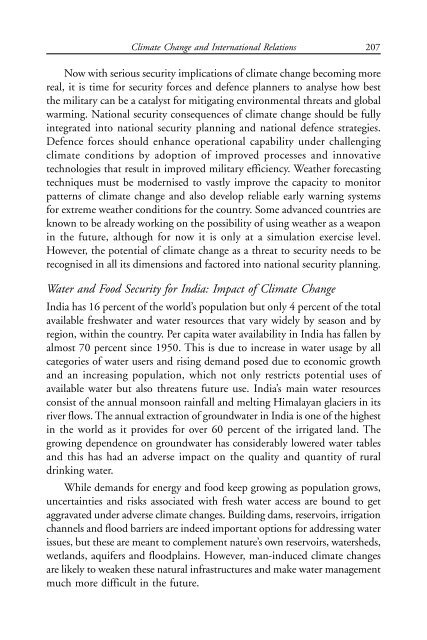ROLE OF TECHNOLOGY INTERNATIONAL AFFAIRS
book_role-of-technology-in-international-affairs_a-mallik_1
book_role-of-technology-in-international-affairs_a-mallik_1
Create successful ePaper yourself
Turn your PDF publications into a flip-book with our unique Google optimized e-Paper software.
Climate Change and International Relations<br />
207<br />
Now with serious security implications of climate change becoming more<br />
real, it is time for security forces and defence planners to analyse how best<br />
the military can be a catalyst for mitigating environmental threats and global<br />
warming. National security consequences of climate change should be fully<br />
integrated into national security planning and national defence strategies.<br />
Defence forces should enhance operational capability under challenging<br />
climate conditions by adoption of improved processes and innovative<br />
technologies that result in improved military efficiency. Weather forecasting<br />
techniques must be modernised to vastly improve the capacity to monitor<br />
patterns of climate change and also develop reliable early warning systems<br />
for extreme weather conditions for the country. Some advanced countries are<br />
known to be already working on the possibility of using weather as a weapon<br />
in the future, although for now it is only at a simulation exercise level.<br />
However, the potential of climate change as a threat to security needs to be<br />
recognised in all its dimensions and factored into national security planning.<br />
Water and Food Security for India: Impact of Climate Change<br />
India has 16 percent of the world’s population but only 4 percent of the total<br />
available freshwater and water resources that vary widely by season and by<br />
region, within the country. Per capita water availability in India has fallen by<br />
almost 70 percent since 1950. This is due to increase in water usage by all<br />
categories of water users and rising demand posed due to economic growth<br />
and an increasing population, which not only restricts potential uses of<br />
available water but also threatens future use. India’s main water resources<br />
consist of the annual monsoon rainfall and melting Himalayan glaciers in its<br />
river flows. The annual extraction of groundwater in India is one of the highest<br />
in the world as it provides for over 60 percent of the irrigated land. The<br />
growing dependence on groundwater has considerably lowered water tables<br />
and this has had an adverse impact on the quality and quantity of rural<br />
drinking water.<br />
While demands for energy and food keep growing as population grows,<br />
uncertainties and risks associated with fresh water access are bound to get<br />
aggravated under adverse climate changes. Building dams, reservoirs, irrigation<br />
channels and flood barriers are indeed important options for addressing water<br />
issues, but these are meant to complement nature’s own reservoirs, watersheds,<br />
wetlands, aquifers and floodplains. However, man-induced climate changes<br />
are likely to weaken these natural infrastructures and make water management<br />
much more difficult in the future.


